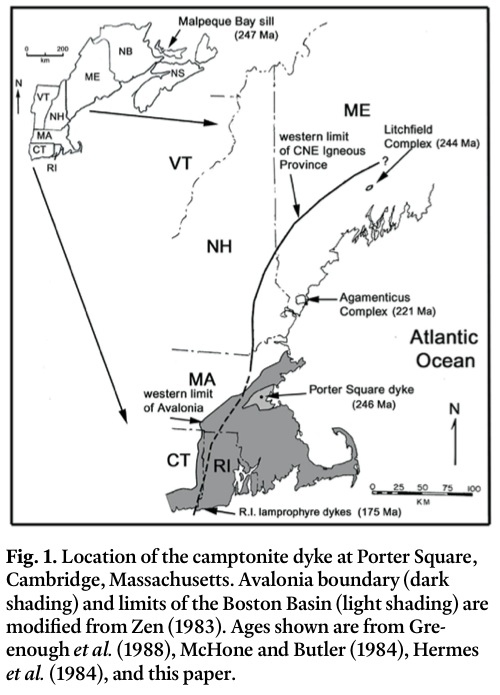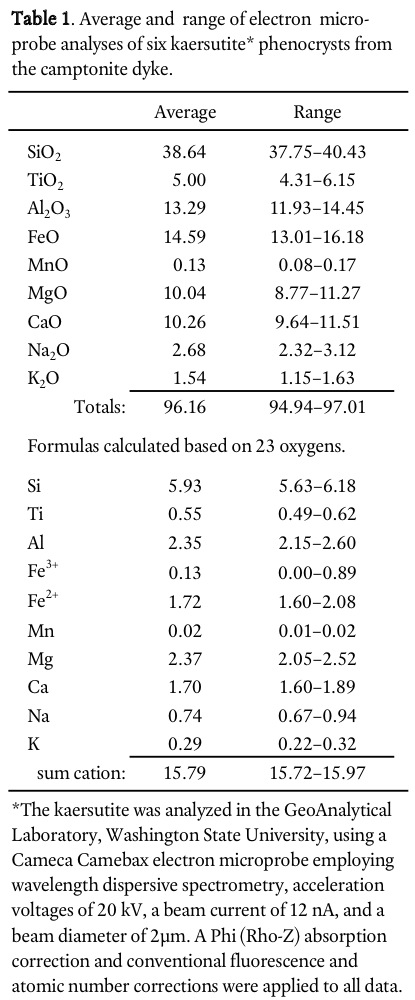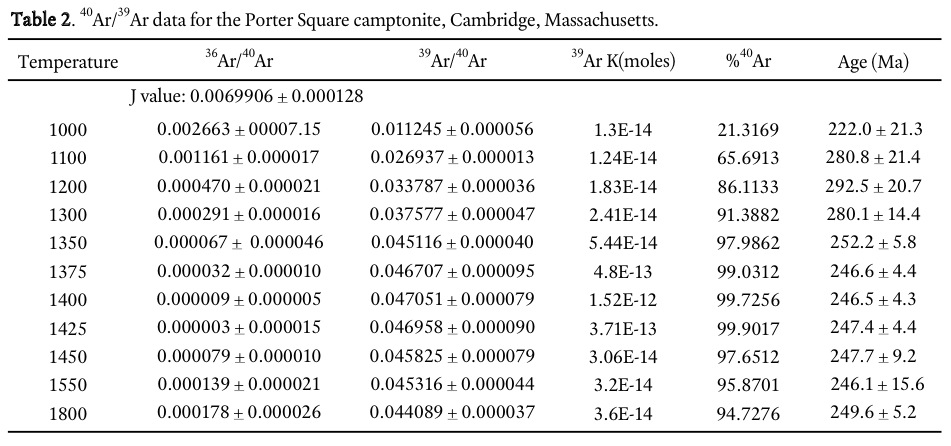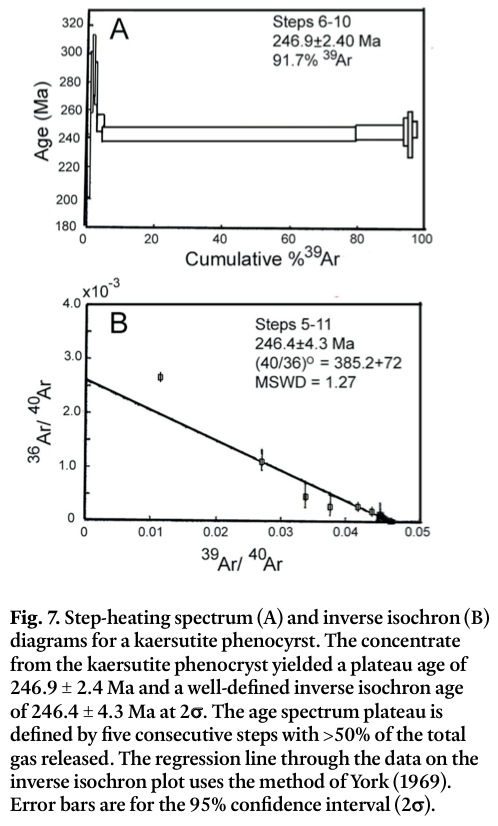Articles
An Early Triassic 40Ar/39Ar age for a camptonite dyke in Cambridge, Massachusetts, USA
Martin E. RossDepartment of Earth and Environmental Sciences, Northeastern University, Boston, Massachusetts 02115, USA <m.ross@neu.edu>
Date received: 28 November 2009 ¶ Date accepted: 18 May 2010 ¶ Date digitally published: 28 July 2010doi: 10.4138/atlgeol.2010.007
ABSTRACT
A 2.4 m-thick megacryst- and xenolith-rich camptonite dyke briefly exposed during excavation of a subway station at Porter Square in Cambridge, Massachusetts, was sampled for petrological study and radiometric dating to constrain its age. The sample yielded a well-defined 40Ar/39Ar age of 246 ± 4 Ma using separates prepared from a ferro-kaersutite mega-phenocryst. This age is the oldest yet reported for a Coastal New England province lamprophyric dyke. The dyke likely reflects regional extension in Avalonia during the initial rifting stage of Pangea to form the North Atlantic Ocean basin. This new age further confirms that mantle upwelling began early in the Late Permian to Triassic as a precursor to the breakup of Pangea some 40 million years later.RÉSUMÉ
Au cours de travaux d’excavation d’une station de métro à Porter Square, à Cambridge, au Massachusetts, un dyke de campronite d’une épaisseur de 2,4 m composé de mégacristaux et riche en xénolite a été exposé brièvement. On y a prélevé un échantillon aux fins d’une étude pétrologique et d’une datation par radiométrie. Par la méthode 40Ar/39Ar, il a été possible de déterminer avec relativement de précision un âge de 246 ± 4 Ma, grâce à des fractions obtenues par préparation d’un mégaphénocristal de ferro-kaersutite. Il s’agit de la plus ancienne datation établie pour un dyke lamprophyrique de la province géologique du littoral de la Nouvelle-Angleterre. Ce dyke rendrait vraisemblablement compte de l’extension régionale de l’Avalonien au cours du stade initial de distension de la masse continentale de Pangée, qui allait entraîner la création du bassin océanique de l’Atlantique Nord. Cette nouvelle datation vient confirmer une fois de plus que la remontée du manteau terrestre a débuté très tôt entre la fin du Permien et le Trias, cet événement géomorphologique annonçant le fractionnement ultérieur du continent de Pangée quelque 40 millions d’années plus tard.[Traduit par la redaction]INTRODUCTION
1 Southeastern New England has been intruded by at least five mafic dyke swarms that range in age from Proterozoic to Triassic (Ross 1990, 1992). Nearly all of the dykes are composed of dolerite but 3 lamprophyric dykes have been identified (Ross 1990) in Avalonia in eastern Massachusetts (Fig. 1). As described by Ross (1981, 1982, 1983, 1990), one of these dykes is classified as camptonite, based on mineralogy (kaersutite and biotite phenocrysts; Ti-augite and olivine in groundmass), alkaline major element chemistry, and high volatile content according to IUGS criteria (Le Maitre et al. 2002). This dyke does not outcrop at surface but was exposed at a depth of approximately 35 m in the 1981 excavation for the Porter Square subway station in Cambridge, Massachusetts, and hence it is hereafter referred to as the Porter Square camptonite.
2 The age of the Porter Square camptonite has not been established with certainty. A K/Ar biotite age of 190 ± 6 Ma was incorrectly reported for it by Kaye (1983) due to an editorial error in which the 202 ± 8 Ma K/Ar whole-rock age for the camptonite was switched with the age for the Medford dolerite dyke (as noted by Ross 1985 and confirmed by H. Krueger, personal communication, 1985). Hill and Ross (1983) determined a broad range of Rb-Sr and Sm-Nd ages for megacrysts and xenoliths in the Porter Square camptonite, but a well-constrained internal Sm-Nd isochron age of 238 ± 26 Ma was determined for a coarse-grained, graphite-garnet-bearing granulite xenolith. Hill and Ross (1983) interpreted the age to represent the cooling age of the dyke at the time it sampled the xenolith and was quenched near the surface. However, this age is substantially older than the 202 ± 8 Ma K/Ar whole-rock age reported by Kaye (1983). It is also older than ages reported for lamprophyre dykes elsewhere in central and southeastern New England, and if correct, indicates that alkaline magmatism in the region preceded the actual opening of the Atlantic Ocean basin by nearly 40 million years. It also appears to contradict the southward younging of alkaline magmatism in the Coastal New England (CNE) province suggested by previously published ages (Fig. 1; McHone 1978; McHone and Butler 1984; Leavy and Hermes 1977; Greenough et al. 1988; Pe-Piper and Reynolds 2000).
3 The present study was undertaken to further investigate the age of the dyke using the 40Ar/39Ar technique and hence to better constrain the age of pre-rifting alkaline magmatism in southeastern New England and establish if it did, indeed, progress from north to south as suggested by other lamprophyre ages from Avalonia (Fig. 1).
Fig. 1. Location of the camptonite dyke at Porter Square, Cambridge, Massachusetts. Avalonia boundary (dark shading) and limits of the Boston Basin (light shading) are modified from Zen (1983). Ages shown are from Gre-enough et al. (1988), McHone and Butler (1984), Hermes et al. (1984), and this paper.GEOLOGICAL SETTING AND FIELD CHARACTERISTICS
4 Avalonia (Fig. 1) makes up the eastern part of the Appalachian orogen from southeastern New England north to Newfoundland (Hibbard et al. 2006). The Boston Basin is a pull-apart basin (Hon et al. 1987) developed within Avalonia in eastern Massachusetts (Fig. 1) and is underlain by the Boston Bay Group of clastic sedimentary rocks and interbedded volcanic rocks of Late Neoproterozoic age (Thompson and Bowring 2000; Bailey and Bland 2001). The Cambridge Formation (also known as Cambridge Argillite) is part of the Boston Bay Group.
5 The Porter Square camptonite was exposed briefly in 1981 during excavation for the Porter Square subway station in Cambridge, Massachusetts, within the Boston Basin. The dyke intruded the Cambridge Argillite, as well as a 15 m-thick, east-trending altered dolerite dyke of unknown age (Ross 1992). Its contacts with both the Cambridge Argillite and the dolerite dyke are sharp and chilled (Fig. 2a). The camptonite dyke is 2.4 m thick, vertical, and trends N15°E, subparallel to the N-S tunnel alignment. It was exposed for several meters in the west wall and floor of the station excavation (Fig. 2b), approximately 35 m south of the north end of the present-day station, and 35 m beneath the ground surface.
Fig. 2. (A) Photograph showing the sharp contact of the camptonite dyke with the Cambridge argillite (banded). (B) The western half of the camptonite dyke shown exposed on the floor of the tunnel excavation. In the lower figure, A shows the western contact with the argillite (light grey at top of photo) and B shows calcite-filled extension gashes within the central zone of the dyke. The light-colored angular inclusions are feldspar xenocrysts and granulite xenoliths. The dark inclusions are ultramafic xenoliths and kaersutite and biotite phenocrysts and/or cognate xenocrysts. Mud covers the dyke in the lower-left third of the photo.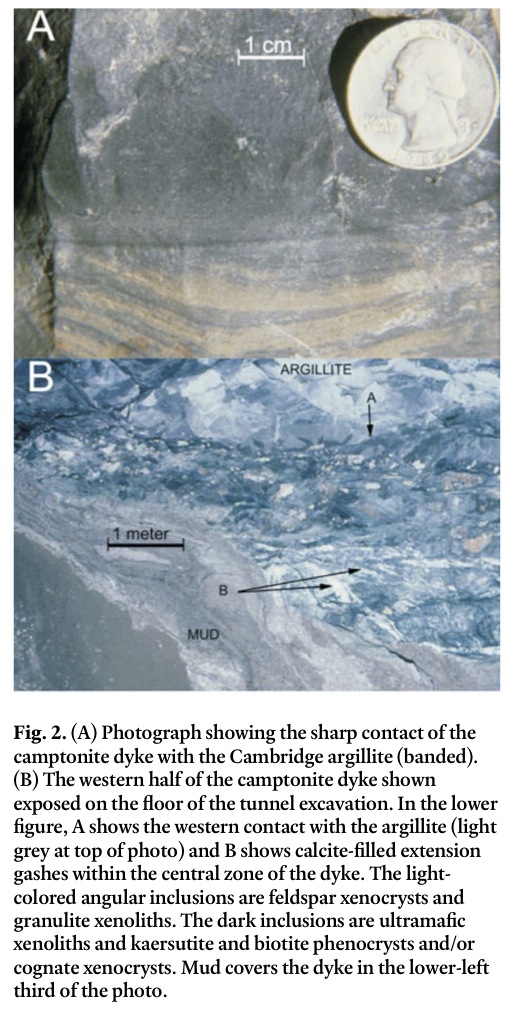
Display large image of Figure 2
6 The dyke contains abundant large (up to at least 9 cm) phenocrysts and xenocrysts in addition to a wide variety of xenoliths that include granulite, dunite, lherzolite, werhlite, harzburgite, and pyroxene peridotite (Ross et al. 1983). The xenoliths appear to be of crustal and upper mantle origin (Ross 1981). The dyke also contains abundant phenocrysts and cog-nate xenocrysts of kaersutite, biotite, and magnetite, and xenocrysts of albite and alkali feldspar.
7 The marginal zones of the dyke are aphyric and free of xenoliths and megacrysts, both of which were concentrated in the dyke interior by flow differentiation and show varying degrees of flow alignment (Fig. 2b). Locally a zone approximately 60 cm thick and 15 cm in from the dyke margin is present in which abundant lath-shaped plagioclase megacrysts up to approximately 1.5 cm in length show pronounced alignment parallel to the dyke margin. The interior of the dyke is cut by calcite veins that run nearly parallel to the dyke as well as oblique extension gashes (Fig. 2b). These veins appear to be associated with post-emplacement shearing rather than reflecting synmagmatic processes.
PETROGRAPHY
8 The groundmass in the dyke consists of 53% plagioclase, 18% augite, 12% biotite, 4% olivine (altered), 11% magnetite, and <1% apatite (based on 1000 points counted in two thin sections). The groundmass is largely intergranular with ferromagnesian microlites occupying interstices between subhedral to anhedral plagioclase laths (Fig 3a). The plagioclase micro-lites range in composition from andesine (An40) to labrador-ite (An58) as determined from electron microprobe analysis. Augite occurs as fresh, pale pinkish-brown, elongate prisms, as uralitized grains, or pseudomorphed by smectite. Euhedral microlites and microphenocrysts of olivine are totally psuedomorphed by smectite or bowlingite ± carbonate. Biotite occurs as fresh anhedral to euhedral microlites. Magnetite forms tiny equant euhedral octahedra. Apatite occurs as small acicular to elongate prismatic grains lying within and across the major groundmass phases (Fig. 3a).
Fig. 3. (A) Photomicrograph (plane-polarized light) of the camptonite groundmass. The white areas are plagioclase microlites. Augite (A) forms pale pinkish microlites with prismatic cleavage and high relative relief. Biotite (B) forms as small, anhedral dark brown interstitial grains. The euhedral grain (O) near the top center of photo is an olivine microphenocryst altered to bowlingite. The black grains are magnetite. The small acicular prismatic grains in plagioclase are apatite. (B) Photomicrograph (plane-polarized light) showing a 0.5 mm euhedral apatite inclusion in a plagioclase xenocryst. (C) Photomicrograph (plane-polarized light) of a rounded apatite xenocryst next to the curved edge of a biotite phenocryst.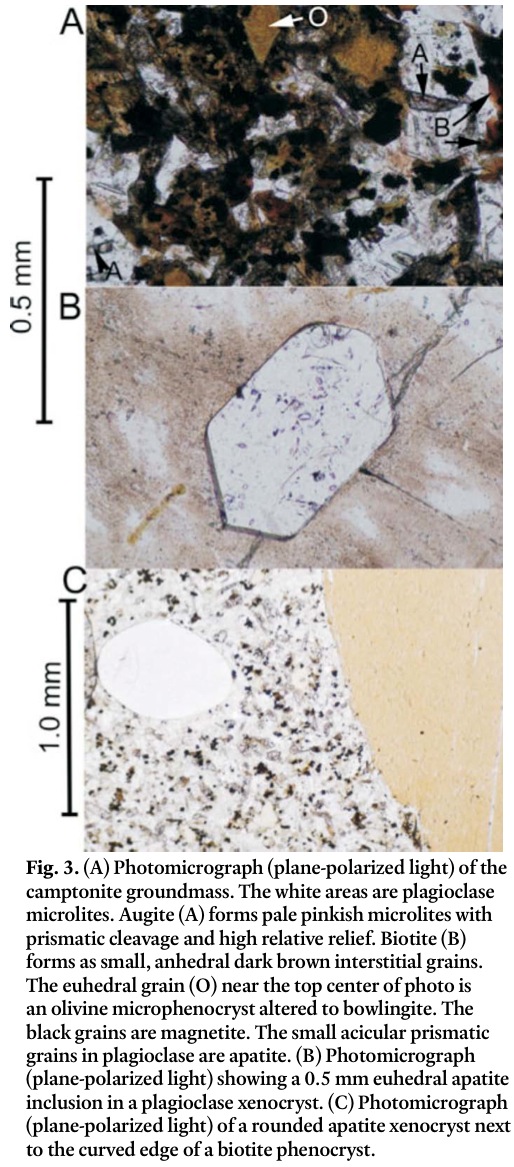
Display large image of Figure 3
9 Scattered rounded larger grains of apatite are present in the groundmass (Fig. 3c) and were likely released from shattered megacrysts and rounded during magma ascent, as megacrysts all contain large euhedral apatite inclusions (Fig. 3b). Thin serpentinite and calcite veins cut the camptonite in some thin sections.
10 Megacrysts include kaersutite, biotite, albite (An6), alkali feldspar, and magnetite up to at least 9 cm in diameter and accounting for 30% of the mode. In hand specimen the feldspars are anhedral to subhedral, and some occur as fragmented grains whereas ferro-kaersutite grains are slightly rounded or subhedral to euhedral (Fig. 4). The feldspar megacrysts are typically rounded and deeply embayed (Fig. 5a). Some individual, rounded and embayed grains of albite are fractured with groundmass infilling fractures but in other instances feldspar aggregates appear to have separated slightly with gaps infilled by the camptonite groundmass (Fig. 5b). They appear to be grains and rock fragments partially broken apart during magma ascent. Albite and alkali feldspar are absent in the groundmass in which the only feldspar is plagioclase in the andesine-labradorite range, indicating that the megacrysts are xenocrysts rather than phenocrysts.
Fig. 4. Photograph of a hand specimen of the dyke showing a partially disaggregated cluster of feldspar xenocrysts partially enclosing a biotite phenocryst (to left of coin), a rounded triangular kaersutite cognate xenocryst (black), and a disaggregated granulite xenolith (bottom right corner).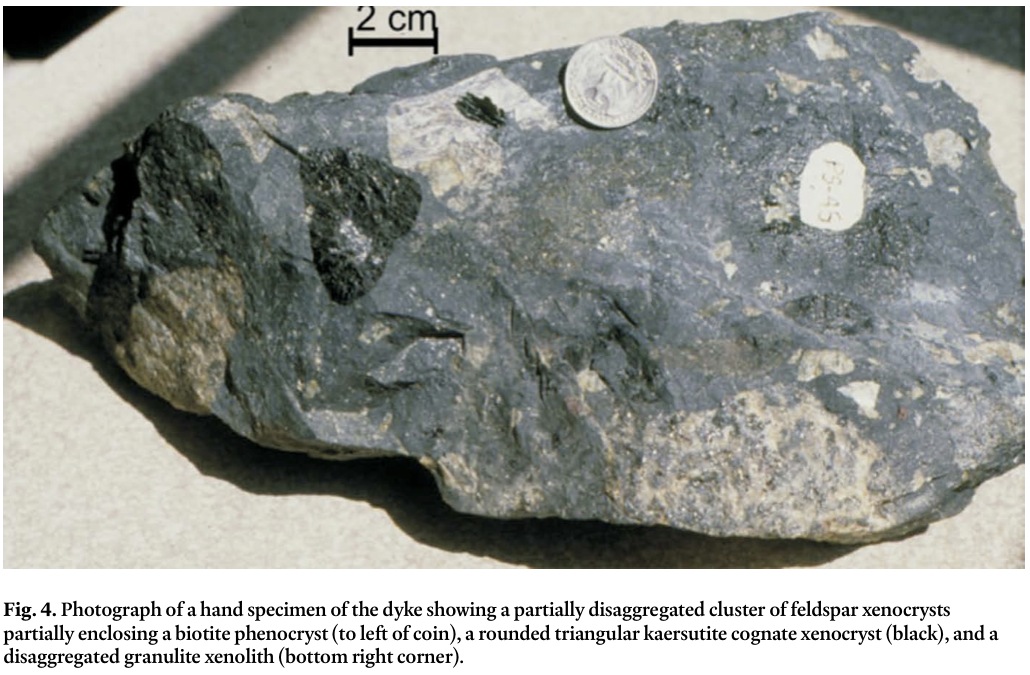
Display large image of Figure 4
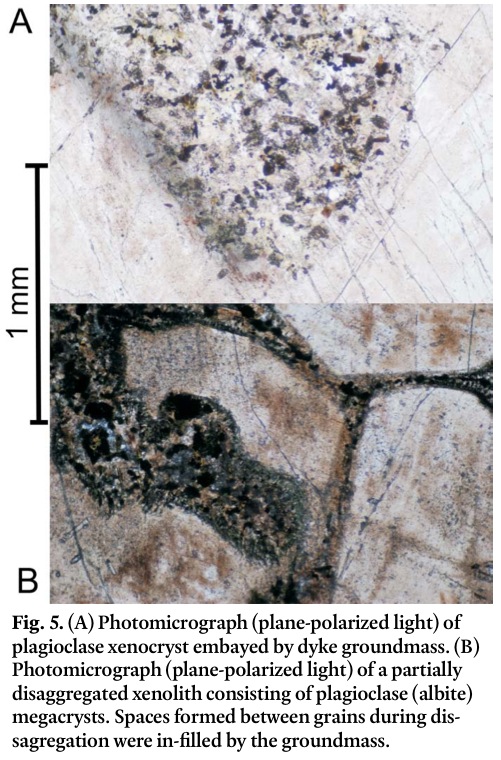
Display large image of Figure 5
11 Magnetite megacrysts up to at least 1 cm in diameter are typically rounded and deeply embayed by (Fig. 6a), and commonly occur clustered with, kaersutite megacrysts which they also embay. Biotite and ferro-kaersutite megacrysts (Table 1) are mostly euhedral in hand specimen but in thin section corners are typically rounded and grains embayed (Figs. 6b and c). Some kaersutite and magnetite megacrysts ophitically enclose plagioclase laths significantly larger than those in the groundmass (Fig. 6d, e). Interstices within clusters of kaersutite and magnetite commonly are filled with microlites of plagioclase, biotite, euhedral kaersutite, altered olivine, altered pyroxene, and magnetite that are slightly coarser grained than the groundmass (Fig. 6f). The presence of the kaersutite microlites further distinguishes this interstitial rock from the groundmass. These interstitial areas are interpreted as having crystallized as an orthocumulate liquid trapped by the settling and accumulation of the kaersutite and magnetite megacrysts in a magma chamber at depth. As cognate xenocrysts and phenocrysts, kaersutite (and biotite) is believed to be a suitable phase for determining the age of the dyke.
Fig. 6. (A) Photomicrograph (plane-polarized light) of a magnetite megacryst deeply embayed by the groundmass. (B) Photomicrograph (plane-polarized light) of a euhedral phenocryst of biotite with slightly rounded corners and embayed by the groundmass. (C) Photomicrograph (plane-polarized light) of a kaersutite phenocryst embayed by the groundmass. (D) Photomicrograph (plane-polarized light) of ophitic inclusions of plagioclase in a kaersutite phenocryst. (E) Photomicrograph (plane-polarized light) of a 1.2mm plagioclase grain subophitically included in a magnetite cognate xenocryst and extending into a groundmass-filled embayment in an adjacent kaersutite phenocryst. (F) Photomicrograph (under cross-polars) of orthocumulate phases including euhedral kaersutite, altered olivine, altered pyroxene, and magnetite filling an interstice between kaersutite phenocrysts and magnetite cognate xenocryst.
Display large image of Figure 6
Table 1. Average and range of electron micro-probe analyses of six kaersutite* phenocrysts from the camptonite dyke.
40AR/39AR DATING
12 The 40Ar/39Ar age was determined by the Cambridge Laboratory for Argon Isotopic Research at Massachusetts Institute of Technology under the direction of Kip Hodges. Fresh fragments of a 3 cm kaersutite phenocryst were readily removed from the host by hand with the aid of dental tools. A double-vacuum resistance furnace for gas extraction was used followed by analysis with a Mass Analyser Products (MAP) 215-50 mass spectrometer according to the procedure described in Nicolaysen et al. (2000). Prior to age calculation, all data were corrected for system blanks, interferences and mass fractionation following the procedure described in Vannay and Hodges (1996). The first heating increment served to degas adsorbed atmospheric argon and the last increment served as a furnace degassing step and was not included in the plateau and isocron calculations. The plateau age was defined using the method of Fleck et al. (1977) and was based on the mean weighted averages of the heating increments. Quoted 2σ errors account for analytical uncertainty as well as scatter around the best-fit line.
13 The concentrate from the kaersutite phenocryst yielded a step-heating spectrum of 246.9 ± 2.4 Ma (Fig. 7a, Table 2) and a well-defined inverse isochron age of 246.4 ± 4.3 Ma (Fig. 7b). The flat age spectra indicate the sample was a closed system since crystallization, undisturbed by physical or chemical processes since cooling through their Ar closure temperature.
Table 2. 40Ar/39Ar data for the Porter Square camptonite, Cambridge, Massachusetts.
Fig. 7. Step-heating spectrum (A) and inverse isochron (B) diagrams for a kaersutite phenocyrst. The concentrate from the kaersutite phenocryst yielded a plateau age of 246.9 ± 2.4 Ma and a well-defined inverse isochron age of 246.4 ± 4.3 Ma at 2σ. The age spectrum plateau is defined by five consecutive steps with >50% of the total gas released. The regression line through the data on the inverse isochron plot uses the method of York (1969). Error bars are for the 95% confidence interval (2σ).DISCUSSION
14 The Mesozoic mafic dykes of eastern Massachusetts consist of tholeiitic olivine-dolerite, transitional-alkalic dolerite, ne-normative alkaline dolerite, and at least three identified alkaline lamprophyres (Ross 1992). The Mesozoic dykes in coastal Massachusetts are the southerly extension of the Coastal New England (CNE) province of McHone and Butler (1984) into southeastern New England with ages ranging from 190 Ma to 226 Ma (Ross 1990, 1992). They are interpreted to have formed in association with the early stage of rifting of Pangea to form the North Atlantic Ocean Basin (Ross and Reidel 1983; Ross 1985, 1990). The province can also be extended farther south to include lamprophyres in Rhode Island described by Leavy and Hermes (1977) and Hermes et al. (1984). The eastern Massachusetts dolerites are more alkalic than Eastern North American (ENA) dolerites to the west of the CNE province (Ross 1992).
15 Of the previously published ages for the Porter Square dyke, all but the 202 ± 8 Ma K/Ar whole-rock age (Kaye 1983) overlap within error of the 246 ± 4.3Ma 40Ar/39Ar age reported here. Hill and Ross (1983) concluded that the age of 238 ± 26 Ma obtained from a granulite xenolith represented the cooling age of the dyke, and is in close agreement with the 246 ± 4.3Ma 40Ar/39Ar age reported here.
16 This Early Triassic age for the Porter Square camptonite is substantially older than the Late Triassic through Early Cretaceous K/Ar ages reported by McHone (1978) for ENA lamprophyre dykes in Vermont, New Hampshire, and Maine and the Middle Jurassic ages reported by Hermes et al. (1984) for monchiquite in Rhode Island. However, it is similar to the 247 Ma age reported for the Malpeque Bay lamprophyric sill on Prince Edward Island by Greenough et al. (1988). It is also similar to 40Ar/39Ar ages ranging between 231 ± 3 Ma and 222 ± 3 Ma reported for lamprophyre dykes near Plymouth, Nova Scotia (Pe-Piper and Reynolds 2000). These ages and that of the Porter Square camptonite fall within the range of ages of alkalic plutons and dolerite dykes in the CNE province of McHone and Butler (1984). McHone and Butler (1984) and McHone (1992) recognized at least three groups of mafic dykes of differing ages along the coast of New England. This was based on K/Ar ages of 3 plutonic complexes ranging from 244 ± 5 Ma in northern Maine (Litchfield complex) to 221 ± 8 Ma (Agamenticus complex) in southern Maine and the fact that Cretaceous and Jurassic lamprophyre and dolerite dykes cut older dolerites in coastal Maine and New Hampshire. Their distribution plus the presence of 175 Ma monchiquite dykes to the south in Rhode Island (Hermes et al. 1984) suggest a southward younging within the CNE province. The Malpeque Bay sill, though substantially north of the CNE province as delineated by McHone and Butler (1984), may represent the northern extension of the province. Its older age suggests that initial mantle upwelling began in the north with CNE magmatism then progressing southward through time.
17 However, the 246.4 ± 4.3Ma age for the Porter Square camptonite reported here indicates that this apparent southward progression of CNE magmatism during the Mesozoic did not continue into coastal Massachusetts. Its Early Triassic age represents the oldest yet reported for CNE magmatism south of the Malpeque Bay sill in Prince Edward Island. These old ages suggest that mantle upwelling began in Late Permian to Early Triassic as a precursor to the breakup of Pangea.
ACKNOWLEDGEMENTS
The author thanks the journal reviewers and editor for their helpful comments and suggestions which led to substantial improvements in the clarity of the manuscript.REFERENCES
Bailey, R.H., and Bland, B.H. 2001. Recent developments in the study of the Boston Bay Group. In Guidebook for geological field trips in New England. Edited by D.P. West and R.H. Bailey. Annual Meeting of the Geological Society of America. Boston, Massachusetts, pp. 1–23.
Fleck, R.J., Sutter, J.F., and Elliot, D.H. 1977. Interpretation of discordant 40Ar/39Ar age spectra of Mesozoic tholeiites from Antarctica. Geochemica Cosmochemica Acta, 41, pp. 15–32. doi:10.1016/0016-7037(77)90184-3
Greenough, J.D., Hayatsu, A.,and Papezik, V.S. 1988. Mineral-ogy, petrology and geochemistry of the alkaline Malpeque Bay sill, Prince Edward Island. Canadian Mineralogist, 26, pp. 97–108.
Hermes, O. D., Rao, J.M., Dickenson, M.P., and Pierce, T.A.1984. A transitional alkalic dolerite suite of Mesozoic age in southeastern New England. Contributions to Mineralogy and Petrology, 86, pp. 386–402. doi:10.1007/BF01187142
Hibbard, J.P., van Staal, C.R., Rankin, D., and Williams H. 2006. Lithotectonic map of the Appalachian orogen (north), Canada-United States of America: Geological Survey of Canada Map 02041A, scale 1:1 500 000, 1 sheet.
Hill, M.D., and Ross, M.E. 1983. Rb-Sr and Sm-Nd study of crustal xenoliths and megacrysts from a camptonite dike in Cambridge, Massachusetts. Geological Society of America Abstracts with Programs,15, p. 135.
Hon, R., Smith, C. J., and Ross, M.E. 1987. Boston Basin; An aborted late Proterozoic transcurrent rift. Geological Society of America Abstracts with Programs, 19, p. 19.
Kaye, C.1983. Discovery of a Late Triassic basin north of Boston and some implications as to post-Paleozoic tectonics in northeastern Massachusetts. American Journal of Science, 203, pp. 1060–1079.
Leavy, B.D., and Hermes, O.D.1977. Mantle xenoliths from southeastern New England. In The mantle sample inclusions in kimberlites and other volcanics, Proceedings International Kimberlite Conference 2nd, Washington D.C. Edited by F.R. Boyd and O.A. Meyer. American Geophysical Union, pp. 374–381.
Le Maitre R. W.(editor), Streckeisen, A., Zanettin, B., Le Bas, M.J., Bonin, B., Bateman, P., Bellieni, G., Dudek, A., Efremova,S., Keller, J., Lamere, J., Sabine,P.A., Schmid, R., Sorensen, H., and Woolley, A.R. 2002. Igneous Rocks: A Classification and Glossary of Terms, Recommendations of the International Union of Geological Sciences, Subcom-mission of the Systematics of Igneous Rocks. Cambridge University Press, 236 p.
McHone, J.G. 1978. Distribution, orientations, and ages of mafic dikes in central New England. Geological Society of America Bulletin, 89, pp. 1645–1655. doi:10.1130/0016-7606(1978)89<1645:DOAAOM>2.0.CO;2
McHone, J.G. 1992. Mafic dike suites within Mesozoic igneous provinces of New England and Atlantic Canada. In Eastern North American Mesozoic magmatism. Edited by J.H. Puffer and P.C. Ragland. Geological Society of America Special Paper 268, pp. 1–11.
McHone, J.G., and Butler, J.R. 1984. Mesozoic igneous provinces of New England and the opening of the North Atlantic Ocean. Geological Society of America Bulletin, 95, pp. 757–765. doi:10.1130/0016-7606(1984)95<757:MIPONE>2.0.CO;2
Nicolaysen, K., Frey, F.A., Hodges, K.V., Weiss, D., and Giret, A. 2000. 40Ar/39Ar geochronology of flood basalts from the Keguelen Archipelago, southern Indian Ocean: implications for Cenozoic eruption rates of the Kerguelen plume. Earth and Planetary Science Letters, 174, pp. 313–328. doi:10.1016/S0012-821X(99)00271-X
Pe-Piper G., and Reynolds, P.H. 2000. Early Mesozoic alkaline mafic dykes, southwestern Nova Scotia, Canada, and their bearing on Triassic-Jurassic magmatism. Canadian Miner-alogist, Mineralogical Association of Canada, 38, pp. 217– 223.
Ross, M. E. 1981. Mafic dikes of northeastern Massachusetts. In Geological field studies in Rhode Island and adjacent areas. Edited by J.C. Boothroyd, and O.D. Hermes. 73rd Annual New England Intercollegiate Geologic Conference Guidebook: Kingston, University of Rhode Island, pp. 285–302.
Ross, M.E. 1982. Mafic dikes of northeastern Massachusetts. Geological Society of America Abstracts with Programs, 14, p. 78.
Ross, M.E.1985. Mafic dike swarms of the Boston platform, eastern Massachusetts. International Conference on Mafic Dyke Swarms (extended abstract), Erindale, University of Toronto, Ontario, pp. 142–147.
Ross, M.E.1990. Mafic dikes of the Avalon Boston terrane, Massachusetts. In Geology of the composite Avalon terrane of southern New England. Edited by A.D. Socci, J.W. Skehan, and G.W. Smith. Geological Society of America Special Paper 245, pp. 133–153.
Ross, M.E. 1992. Petrology and tectonic significance of Mesozoic mafic dikes of the coastal New England igneous province, Massachusetts. In Eastern North American Mesozoic magmatism. Edited by J.H. Puffer, and P.C. Ragland, P.C. Geological Society of America Special Paper 268, pp. 63–74.
Ross, M.E., and Reidel,S.P. 1983. Dolerite and lamprophyre dikes of northeastern Massachusetts: Geological Society of America, Abstracts with Progams, 15, p. 674.
Ross, M.E., Knowles, C.R., and Chamness, J.S. 1983. Megacrysts, xenocrysts, and ultramafic xenoliths from a camp-tonite dike in Cambridge, Massachusetts. Geological Society of America Abstracts with Programs, 15, p. 174.
Thompson, M.D., and Bowring, S.A. 2000. Age of the Squantum “tillite”, Boston Basin, Massachusetts: U-Pb zircon constaints on terminal Neoproterozoic glaciations. American Journal of Science, 300, pp. 630–655. doi:10.2475/ajs.300.8.630
Vannay, J.C., and Hodges, K.V. 1996. Tectonometamorphic evolution of the Himalayan metamorphic core between the Annapurna and Dhaulagiri, central Nepal. Journal of Metamorphic Geology, 14, pp. 635–656. doi:10.1046/j.1525-1314.1996.00426.x
York, Y. 1969. Least-squares fitting of a straight line with correlated errors. Earth and Planetary Science Letters, 5, pp. 320–324. doi:10.1016/S0012-821X(68)80059-7
Zen, E-an. 1983. Bedrock geologic map of Massachusetts. U. S. Geological Survey Map, 3 map sheets, scale 1:250 000.
Editorial responsibility: Sandra M. Barr
